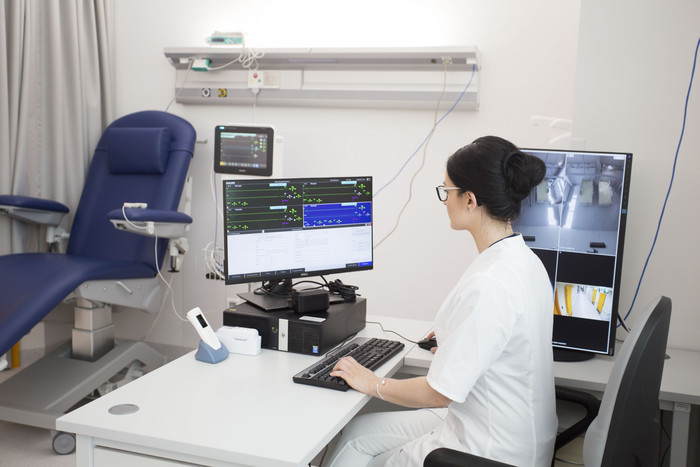This project consists of the stages presented below along with the corresponding interventions allowing for monitoring the patient’s health, side effects of drugs, and positive effects of therapy. The planned intervention comprises the inclusion of one drug (metoprolol) administered in one daily dose adjusted to the patient’s weight. It should be taken into account that the dose will be regularly verified with respect to the patient’s body weight, and if necessary, it will be modified to match the current measurements.
1. Eligibility criteria for patients to be included in the study.
At the screening stage, it will be necessary to evaluate both the inclusion and the exclusion criteria for each patient. After the patient’s guardians (or in the case of the patient who is over 13 years old, both the guardian and the patient) have expressed a written informed consent, the patients with genetically confirmed Duchenne muscular dystrophy will be qualified for the project. The patients will be qualified provided that they do not participate in any other clinical research, do not take any drugs from the beta group blockers, and they do not present any symptoms of bradycardia and left ventricular ejection fraction (LVEF) <>. As patients must be assessed on regular basis at a research centre, only the patients whose guardians have declared that they can travel to the centre on specific dates will participate in the project. For patients commuting from outside the Pomeranian Voivodeship, financial support up to PLN 460 is planned (co-financing of travel and accommodation costs for people commuting from outside the Pomeranian Voivodeship). As part of the qualification stage, a set of exams aimed at assessing the patient’s general health, cardiac function and respiratory functions will be carried out. The exams will involve both the patient’s medical history and physical examinations, electrocardiography and echocardiography, Holter monitoring and 24-hour ambulatory blood pressure measurement (ABPM). If, on the basis of the results of these exams, the patient is found eligible to participate in the MeDMD project, on the second day of their stay at the research center, laboratory tests, spirometry and magnetic resonance imaging of the heart will be performed.
2. Randomization procedure
With a view to obtaining the most reliable results with regard to the efficacy of metoprolol treatment in preventing the decline in cardiac function and cardiomyopathy in patients with Duchenne muscular dystrophy, the project will be a randomized trial. This means that the patients will be randomly divided into two groups with an equal number of patients. From the day of the therapy initiation until the results of the interim analysis are obtained, this trial will be double-blind, which means that neither the patients nor the doctors know who is receiving a drug or a placebo. After the randomization procedure has been implemented, neither the doctor nor the patient will be able to change the assignment to the group. It is a standard solution used worldwide to conduct a clinical trial.
3. Initiation of the drug or placebo therapy
The patient eligible for participating in the project will start taking the drug (metoprolol) or the placebo. The substance will be taken orally, once a day, in a daily dose adjusted to the patient’s body weight.
The placebo will be indistinguishable from the drug, i.e. it will be a tablet of the same size, shape, color and weight as the dose of the drug that a given patient would receive. Patients will have follow-up visits at the clinical centre and their health status will also be monitored and reported at home. Follow-up visits will take place 1, 3, 6 months after the therapy initiation, and then every six months. The medical exams checking the patient’s health will be performed at every follow-up visit (point 1 and “patient evaluation scheme” point)
Home monitoring of the patients’ health will be based on measuring their systolic and diastolic blood pressure, heart rate and reporting the patient’s well-being; this information will be provided to researchers twice a week on specific days using telemedicine solutions. Contrast-enhanced MRI (Gadolinium-based contrast agents) of the heart will be performed after the patient has been qualified for the project, at the intermediate evaluation stage and at the end of the project.
4. Periodic analysis
After 30 months of the clinical trial, an interim analysis of the results will be carried out. The main aim of this analysis will be to identify potential side effects resulting in worsening of the health of the patients treated with the drug. In this case, the administration of metoprolol will be discontinued, but the evaluation schema of the study population (time points and follow-up visits) will not be changed. If the analysis shows that the treatment is effective, all patients (including those previously receiving a placebo) will receive the active drug. In case of inconclusive results of the interim analysis, the project will continue without being modified and will still be a double-blind one.
5. Project completion
The clinical phase of the project will be completed 60 months after its commencement. During the last clinical trial visit, a study protocol will be prepared following the exams and tests performed during the patient qualification and follow-up stages. The MRI of the heart will be performed for the third time. The data obtained in this way will allow the comparison of the health of the patients at the time of qualifying for the inclusion in the project and at the end point. This will also enable the evaluation of the metoprolol efficacy and safety as a cardioprotective drug in patients with Duchenne muscular dystrophy. The patient’s health condition will be monitored and reported during follow-up visits at the UCC Rare Diseases Centre as well as at home, in accordance with the project protocol. The guardians of the project participants will be provided with education in the field of drug use, monitoring at the patient’s home, telemetry reporting, and proceeding in the event of side effects.
